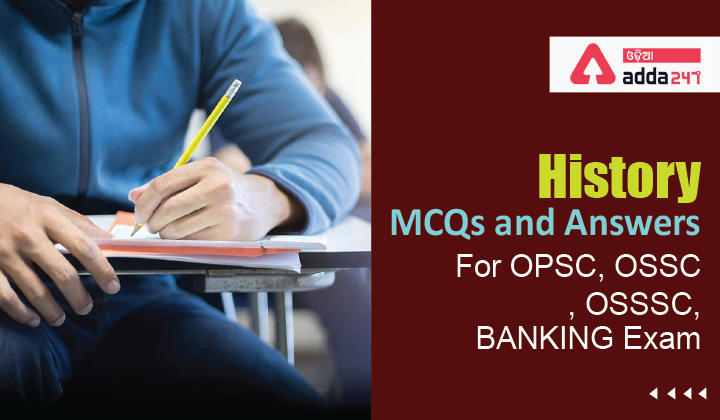History MCQs and Answers: History MCQs are very important for OPSC, OSSC, OSSSC & Other State Exams. Aspirants who are willing to apply for the various Government exams 2022 must go through the topics of History for competitive exams, as History is a key part of the syllabus.
Download ADDA247 Odia APP – Appear Latest Exam Test Series & Live Classes
Q1. Which one of the following Mughal buildings is said to possess the unique feature of being exactly equal in length and breadth?
(a) Agra Fort
(b) Red Fort
(c) Taj Mahal
(d) BulandDarwaza
S1.Ans.(c)
Sol.The Taj Mahal is an ivory-white marble mausoleum on the south bank of the Yamuna river in the Indian city of Agra. It was commissioned in 1632 by the Mughal emperor, Shah Jahan, to house the tomb of his favourite wife, Mumtaz Mahal.
Q2. In the Maratha Empire the Prime Minister in the council of ministers was called?
(a) Peshwa
(b) Sachiv
(c) Mantri
(d) Samanta
S2.Ans(a)
Sol.APeshwa was the equivalent of a modern Prime Minister in the Maratha Empire.
Q3. Name the British officer, who issued the infamous ‘crawling order’ whereby Indians had to crawl on all fours to pass an alley?
(a) General Dyer
(b) Warren Hastings
(c) Lord Irwin
(d) Lord Curzon
S3. Ans.(a)
Sol. General Dyer issued the infamous ‘crawling order’ whereby Indians had to crawl on all fours to pass an alley.
General Dyer promulgated his infamous ‘crawling order’ on April 19, 1919, After six days of the JallianwalaBagh massacre.
Q4. The Vernacular Press Act of 1878 was repealed during the tenure of Viceroy ______.
(a) Lord Ripon
(b) Lord Dufferin
(c) Lord Lansdowne
(d) Lord Northbrook
S4. Ans.(a)
Sol. The Vernacular Press Act of 1878 was repealed during the tenure of Viceroy Lord Ripon.
The Vernacular Press Act (1878) was enacted to curtail the freedom of the Indian press and prevent the expression of criticism toward British policies.
The Act was proposed by Lytton, then Viceroy of India, and was unanimously passed by the Viceroy’s Council on 14 March 1878.
Q5. The Chalukya king Vikramadityais described in the VikramankadevaCharit written by the Kashmiri poet _______.
(a) Jayank
(b) Orator
(c) Bilhan
(d) Kalhan
S5. Ans.(c)
Sol. The Chalukya king Vikramadityais described in the VikramankadevaCharit written by the Kashmiri poet Bilhana.
King Vikramaditya VI (or King Vikramaditya) appointed him as Vidyapathi in his court.
Bilhana was an 11th-century Kashmiri poet.
He is known for his love poem, the Caurapancasika.
Q6. Which of the following texts provides evidence that Prithvi raj III wanted to conquer the whole world?
(a) Tabgat-i-Nasiri
(b) Taj-ul-Massir
(c) PrithvirajRaso
(d) PrithvirajPrabandha
S6.Ans.(c)
Sol. The PrithvirajRaso is a Brajbhasha epic poem about the life of the 12th century Indian king Prithviraj Chauhan. It is wriiten by Chand Bardai, who according to the text was a court poet of the king.
Q7. Which of the following Mughal rulers remained in the captivity of his son?
(a) Akbar
(b) Aurangzeb
(c) Shahjahan
(d) Jahangir
S7. Ans.(c)
Sol.Mughal emperor Shahjahan, remained in captivity of his son Aurangzeb.
Aurangzeb put his father under house arrest in Agra Fort from July 1658 until his death in January 1666.

Q8. Where is Muslim mosque situated where a hair of pagamber Mohammad Saheb has been preserved?
(a) Ajmer
(b) Ahmedabad
(c) Srinagar
(d) Mecca
S8.Ans.(c)
Sol.TheHazratbalShrine, is a Muslim shrine in Hazratbal, Srinagar, Jammu & Kashmir. It contains a relic, the Moi-e-Muqqadas, believed by many Muslims of Kashmir to be a hair of prophet Muhammad.
Q9. The Mughal painting reaches its zenith during the reign of:
(a) Akbar
(b) Jahangir
(c) Shahjahan
(d) Aurangzeb
S9.Ans.(b)
Sol.Jahangir had a very discriminating eye and Mughal painting reached its climax of glory during his reign.
Q10. The Subsidiary Alliance System, through which the British were responsible for protecting their Indian allies from external and internal threats to their power, was devised by:
(a) Lord Wellesley
(b) Lord Curzon
(c) Lord Dalhousie
(d) Lord Bentinck
S10. Ans.(a)
Sol.The Subsidiary Alliance System, through which the British were responsible for protecting their Indian allies from external and internal threats to their power, was devised by Lord Wellesley.
Q11. Under the Mahalwari System, who was incharge of collecting revenue from land and paying it to East India Company?
(a) Village Headman
(b) Zamindar
(c) Taluqdar
(d) Tehsildar
S11. Ans.(a)
Sol.Under the Mahalwari System, the land revenue was collected from the farmers by the village headman on the behalf of the whole village.
Mahalwari System was introduced by Holt Mackenzie in the north western province of Bengal presidency in 1822 AD.
It was introduced in central province, North-West frontier, Agra, Oudh (Awadh), Punjab etc.
Q12. The famous Kohinoor diamond was produced from one of the mines in
(a) Orissa
(b) Chhota Nagpur
(c) Bijapur
(d) Golconda
S12.Ans.(d)
Sol.The famous Koh-i-Noor (“mountain of light” in Persian) diamond weights 105.60 cts and is considered one of the 5 priciest diamonds in the world was mined in Golconda, India.
Q13. The Khilji Sultans of Delhi were
(a) Mongols
(b) Afghans
(c) Turks
(d) A Jat tribe
S13.Ans.(c)
Sol.TheKhiljis were one of the clans of the Turks. The rule of Khilji Dynasty has reached the power and influence of Delhi Sultanate to its peak. The Khilji’s were marked by wars and internal conflicts.
Q14. Who along with Bhagat Singh threw a bomb in the Legislative Assembly in April 1929?
- Sukhdev
- Jatin Das
- Batukeshwar Dutta
- Ajay Ghosh
S14. Ans.(c)
Sol.BatukeshvarDuttalong with Bhagat Singh threw a bomb in the Legislative Assembly in April 1929.
Q15. When was the Lahore Session of the Indian National Congress held, where everyone present in the meeting pledged to mark 26 January as ‘Independence Day’?
- 14 January 1937
- 26 March 1935
- 31 December 1929
- 31 October 1945
S15. Ans.(c)
Sol.The Lahore Session of the Indian National Congress was held on 31st December 1929, where everyone present in the meeting pledged to mark 26 January as ‘Independence Day’.
The flag of India was also hoisted by Jawaharlal Nehru on 31 December 1929 on the banks of Ravi river, in Lahore
History MCQs and Answers For Odisha Exam
Reasoning MCQs and Answers For Odisha Exam
English MCQs and Answers For Odisha Exam
General Awareness MCQs and Answers For Odisha Exam














